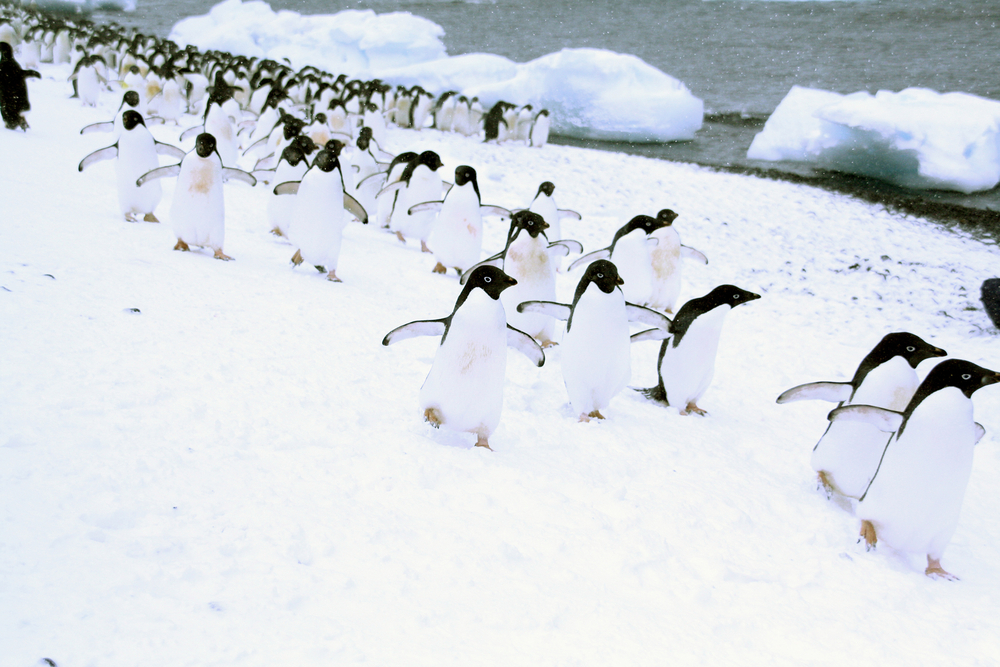
News reports emerged this week suggesting that as many as 140,000 Adélie penguins may have died on Cape Denison in Antarctica, after an iceberg the size of Rome slammed into the coast and blocked their access to the sea.
According to the journal Antarctic Science, the snappily named B09B iceberg, which measures 1,120 sq miles (2,900 sq km) and had been floating around the coastline for some years, finally bounced off the Mertz Glacier Tongue and became wedged in Commonwealth Bay in 2010, preventing sea ice from leaving the bay and effectively blocking off access to feeding grounds for the resident colony of Adélie penguins.
The birds, which stand just 70cm high, were forced to embark on an epic 37-mile (60km) trek in order to find food, a situation which scientists says has led to the reduction of the colony from an estimated 150,000 to just 10,000 in the space of a few years. The dramatic claim comes as results were published from a survey conduced between 2013 and 2014 by the Climate Change Research Centre at the University of New South Wales in Australia, in conjunction with New Zealand’s West Coast Penguin Trust.
Adélie penguins breed between October and February, and then travel back and forth from their nesting site to the ocean to gather krill and other food for their young. Chris Fogwill, one of the scientists involved in the study, described the scene the team encountered after the iceberg radically changed the landscape. ‘We saw a lot of dead carcasses, particularly the young, which was terrible,’ he told The Associated Press. ‘But the really important thing is that the penguins are just not coming back to that area.’

Some scientists say the Commonwealth Bay colony may never recover from this catastrophe, and it might disappear altogether within 20 years. Other experts believe the size of the disaster is being overblown in the press, pointing to a similar situation that occurred in 2001, when an iceberg grounded in the southern Ross Sea and the resident Ross Island penguins simply migrated to nearby colonies until the ice broke up.
‘Just because there are a lot fewer birds observed doesn’t automatically mean the ones that were there before have perished,’ Michelle LaRue, a penguin population researcher at the University of Minnesota in Minneapolis, told Live Science this week. ‘They easily could have moved elsewhere, which would make sense if nearby colonies are thriving.’
The Australian team also concede that the absent Adélie could have joined other groups (acknowledging that neighbouring colonies do seem to be thriving), and said that it’s not uncommon to discover abandoned and recolonised penguin camps across the continent, with the birds being adept at responding to the ever-changing conditions of their icy and unpredictable environment.
The Cape Denison Adélie penguin colony was first visited in 1913, during Australian explorer Douglas Mawson’s Antarctica expedition, just a year after George Murray Levick, a scientist who had travelled with the 1910-13 Scott Antarctic Expedition, spent a full Antarctic summer observing a colony of Adélies at Cape Adare.
Famously, Levick was so horrified by the sexual behaviour of ‘hooligan males’ within the Adélie penguin pack—whom he witnessed indulging in necrophilia, sexual coercion, sexual and physical abuse of chicks and homosexual behaviour—that he initially wrote his report in Greek so only educated gentlemen could read it, and then self-censored his more comprehensive work, The Natural History of the Adélie Penguin to remove references to the penguins perversions. (Later studies proved his observations correct, and Adélies have even been observed engaging in prostitution, with nesting rocks being used as currency for sexual favours.)

Although the Commonwealth Bay incident is not thought to be directly related to global warming—and with a total population numbering well over 7 million the Adélie are far from threatened—the species has been called the bellwether of climate change by people including Douglas Russell, curator of birds at the Natural History Museum. ‘The Adélie needs pack ice from which to dive to get fish,’ says Russell. ‘When that ice disappears, numbers may crash–and we will have a clear warning that things are getting bad.’
Antarctica’s Adélie penguin population is now being tracked by satellites, which can monitor their movements without getting close enough to be offended by their raunchy sexual shenanigans.
